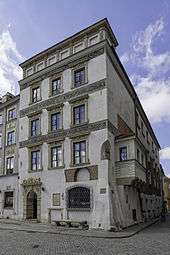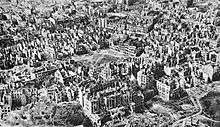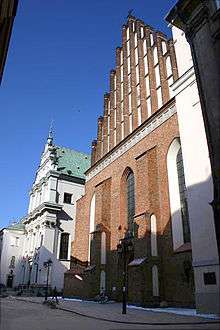Warsaw Old Town
| Historic Centre of Warsaw | |
|---|---|
| Name as inscribed on the World Heritage List | |
|
| |
| Type | Cultural |
| Criteria | ii, vi |
| Reference | 30 |
| UNESCO region | Europe and North America |
| Inscription history | |
| Inscription | 1980 (4th Session) |
The Warsaw Old Town (Polish: Stare Miasto, and collectively with the New Town, known colloquially as: Starówka) is the oldest part of the capital city. It is bounded by the Wybrzeże Gdańskie, along with the bank of Vistula river, Grodzka, Mostowa and Podwale Streets. It is one of the most prominent tourist attractions in Warsaw.
The heart of the area is the Old Town Market Place, rich in restaurants, cafés and shops. Surrounding streets feature medieval architecture such as the city walls, the Barbican and St. John's Cathedral.
History

The Old Town was established in the 13th century. Initially surrounded by an earthwork rampart, prior to 1339 it was fortified with brick city walls. The town originally grew up around the castle of the Dukes of Mazovia that later became the Royal Castle. The Market Square (Rynek Starego Miasta) was laid out sometime in the late 13th or early 14th century, along the main road linking the castle with the New Town to the north.


Until 1817 the Old Town's most notable feature was the Town Hall built before 1429. In 1701 the square was rebuilt by Tylman Gamerski, and in 1817 the Town Hall was demolished. Since the 19th century, the four sides of the Market Square have borne the names of four notable Poles who once lived on the respective sides: Ignacy Zakrzewski (south), Hugo Kołłątaj (west), Jan Dekert (north) and Franciszek Barss (east).
In the early 1910s Warsaw Old Town was the home of the prominent Yiddish writer Alter Kacyzne, who later depicted life there in his 1929 novel "שטאַרקע און שוואַכע" (Sterke un Sweche, "The Strong and the Weak"). As depicted in the novel, the Old Town at that time was a slum neighborhood, with poor families - some Jewish, other Christian - living very crowded in subdivided tenements which had once been aristocrats' palaces. Parts of it were bohemian, with painters and artists having their studios, while some streets were a Red-light district housing brothels.
In 1918 the Royal Castle once again became the seat of Poland's highest authorities: the President of Poland and his chancellery. In the late 1930s, during the mayoralty of Stefan Starzyński, the municipal authorities began refurbishing the Old Town and restoring it to its former glory. The Barbican and the Old Town Market Place were partly restored. These efforts, however, were brought to an end by the outbreak of World War II.
During the Invasion of Poland (1939), much of the district was badly damaged by the German Luftwaffe, which targeted the city's residential areas and historic landmarks in a campaign of terror bombing.[2][3] Following the Siege of Warsaw, parts of the Old Town were rebuilt, but immediately after the Warsaw Uprising (August–October 1944) what had been left standing was systematically blown up by the German Army. A statue commemorating the Uprising, "the Little Insurgent," now stands on the Old Town's medieval city wall.[4]
After World War II, the Old Town was meticulously rebuilt.[3] As many as possible of the original bricks were reused. However the reconstruction was not necessarily built accurately to pre-war Warsaw, often by deferring to an earlier period, attempting to improve upon the original, or by adding an authentic looking facade to cover a more modern building.[5] The rubble was sifted for reusable decorative elements, which were reinserted into their original places. Bernardo Bellotto's 18th-century vedute, as well as pre-World War II architecture students' drawings, were used as essential sources in the reconstruction effort, however Bellotto's drawings were not immune to artistic licence and embellishment, and in some cases this has been transferred into the reconstructed buildings.
Squares
The Old Town Market Place (Rynek Starego Miasta), which dates back to the end of the 13th century, is the true heart of the Old Town, and until the end of the 18th century it was the heart of all of Warsaw.[6] Here the representatives of guilds and merchants met in the Town Hall (built before 1429, pulled down in 1817), and fairs and the occasional execution were held. The houses around it represented the Gothic style until the great fire of 1607, after which they were rebuilt in late-Renaissance style.[7]
Castle Square (plac Zamkowy) is a visitor's first view of the reconstructed Old Town, when approaching from the more modern center of Warsaw. It is an impressive sight, dominated by Zygmunt's Column, which towers above the beautiful Old Town houses. Enclosed between the Old Town and the Royal Castle, Castle Square is steeped in history. Here was the gateway leading into the city called the Kraków Gate (Brama Krakowska).[8] It was developed in the 14th century and continued to be a defensive area for the kings. The square was in its glory in the 17th century when Warsaw became the country's capital and it was here in 1644 that King Władysław IV erected the column to glorify his father Sigismund III Vasa, who is best known for moving the capital of Poland from Kraków to Warsaw.[8]
Canon Square (plac Kanonia), behind St. John's Cathedral, is a small triangular square.[9] Its name comes from the 17th-century tenement houses which belonged to the canons of the Warsaw chapter.[9] Some of these canons were quite famous, like Stanisław Staszic who was the co-author of the Constitution of May 3, 1791. Formerly, it was a parochial cemetery, of which there remains a Baroque figure of Our Lady from the 18th century.[9] In the middle of the square, is the bronze bell of Warsaw, that Grand Crown Treasurer Jan Mikołaj Daniłowicz, founded in 1646 for the Jesuit Church in Jarosław.[9] The bell was cast in 1646 by Daniel Tym - the designer of the Zygmunt's Column. Where the Canon Square meets the Royal Square is a covered passage built for Queen Anna Jagiellon in the late 16th century and extended in the 1620s after Michał Piekarski's failed 1620 attempt to assassinate King Sigismund III Vasa as he was entering the Cathedral.[10] Also the thinnest house in Warsaw is located there.
Recognition
Warsaw's Old Town has been placed on the UNESCO's list of World Heritage Sites as "an outstanding example of a near-total reconstruction of a span of history covering the 13th to the 20th century.[3]
The site is also one of Poland's official national Historic Monuments (Pomnik historii), as designated September 16, 1994. Its listing is maintained by the National Heritage Board of Poland.
See also
| Wikimedia Commons has media related to Old Town of Warsaw. |
References
- In-line:
- ↑ "Kamienica "Pod Okrętem"". ePrzewodnik / Perełki Warszawy on-line (in Polish). Retrieved 2009-03-16.
- ↑ "Historic Centre of Warsaw". whc.unesco.org. Retrieved 2008-08-18.
- 1 2 3 "Old Town". www.destinationwarsaw.com. Retrieved 2008-08-18.
- ↑ "Warsaw's Old Town". www.ilovepoland.co.uk. Retrieved 2008-08-18.
- ↑ Template:99% invisible episode 72
- ↑ "The Old Town Market Square". eGuide / Treasures of Warsaw on-line. Retrieved 2008-07-08.
- ↑ Marek Lewandowski. "Rynek Starego Miasta". www.stare-miasto.com (in Polish). Retrieved 2008-07-08.
- 1 2 "Plac zamkowy". zapiecek.com (in Polish). Retrieved 2008-07-01.
- 1 2 3 4 "Canonicity". eGuide / Treasures of Warsaw on-line. Retrieved 2009-05-12.
- ↑ Stefan Kieniewicz, ed., Warszawa w latach 1526-1795 (Warsaw in 1526–1795), vol. II, Warsaw, 1984, ISBN 83-01-03323-1.
- General:
Features
Churches
 St. John's Cathedral, 14th century
St. John's Cathedral, 14th century Jesuit Church, 1609
Jesuit Church, 1609 St. Martin's Church, 1353-1752
St. Martin's Church, 1353-1752
Defensive walls
 Warsaw Barbican, 1548
Warsaw Barbican, 1548 Gunpowder Tower, after 1379
Gunpowder Tower, after 1379- Defensive walls, detail
Others
 Szeroki Dunaj Street
Szeroki Dunaj Street Piwna Street
Piwna Street Canonicity Square
Canonicity Square St John Street
St John Street
External links
| Wikivoyage has a travel guide for Warsaw - Old & New Town. |
| Wikimedia Commons has media related to Old Town in Warsaw. |
Coordinates: 52°14′59″N 21°00′44″E / 52.2498°N 21.0122°E